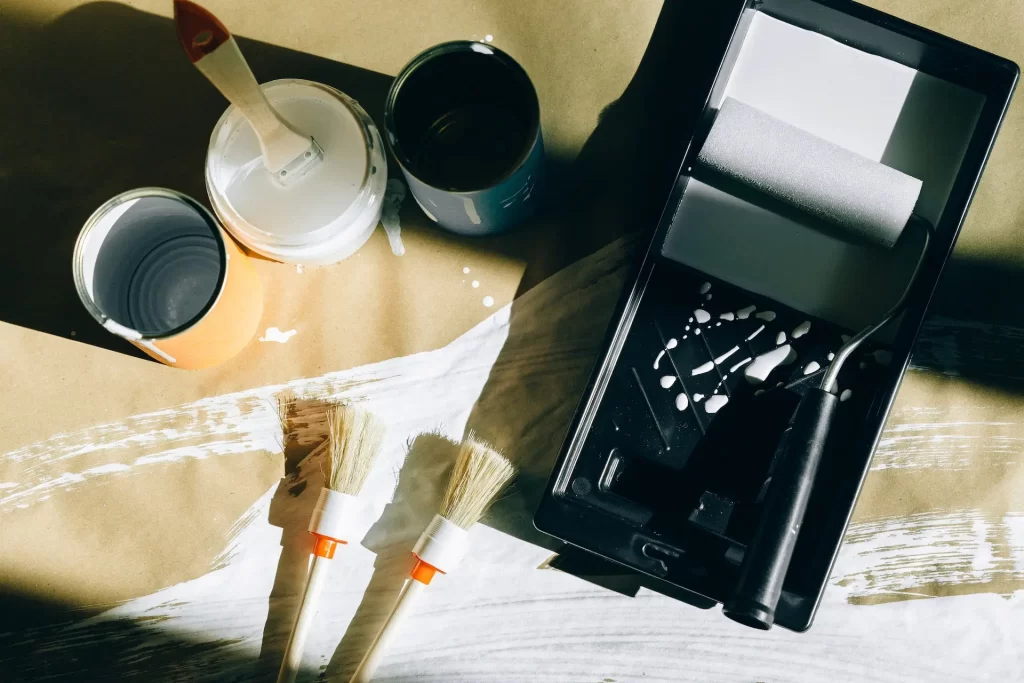
Have you ever chosen what initially seemed to be A Guide to Mixing Your Own Colors living room, only to find out once it dried that it was slightly too dark or had a faint undertone you weren’t expecting? Perhaps you had a specific color in mind for your painting project but were unable to locate it among the selections provided by the typical paint deck. The good news is that you can take control of the situation by creating a unique paint color palette!
You’ll need a dash of daring, a desire to try new things, and a sprinkle of patience to set out on this creative trip. It’s easy to combine your own paint colors, giving you the freedom to choose not just your favorite colors. while eliminating the inconvenience of buying gallons of paint that might not quite fit your idea. but also give your room a personalized touch.
Working with sample paint cans makes this project even more approachable because you won’t need to have a thorough understanding of color theory. Remember that the final appearance can be influenced by the paint finish you select, making it appear a little lighter or darker and altering its reflectivity. When blending your custom color, stay true to the sheen you want and avoid combining several paint sheens. This technique may be used to create the ideal bespoke color for your project with both interior and exterior paint. So let’s get started and let your inner color out!
Jennifer Rizzo TV
To craft your own custom paint color, start by selecting the primary paint shade that comes closest to your desired hue. I find that sample cans from the paint store work exceptionally well for this purpose. Additionally, acquire cans of black and white paint to have on hand. Trust your intuition when making color decisions; if you feel that the color could use a subtle adjustment, consider purchasing paints with hints of “green” or “yellow.” In some cases, you can achieve your desired color more cost-effectively with paint samples compared to artist-grade paints.
Here’s a step-by-step process for mixing your custom paint color:
1. Begin by pouring about half a cup of the main base color into a small plastic cup. Choose the primary paint shade that most closely resembles the color you want to create your own bespoke paint color. For this, I’ve discovered that paint store sample cans work incredibly well. Also, get some black and white paint in cans so you have some on hand. When choosing colors, trust your instinct; if you think the hue needs a small modification, think about buying paints that have hints of “green” or “yellow.” Occasionally, using paint samples rather than artist-grade paints will allow you to get your desired hue more affordably.
An explanation of how to mix your own paint color is provided below:
2. Whether you wish to darken (using black) or brighten (using white) the shade, gradually add tiny increments of the new hue. Keep track of the quantities as you attempt to add these increments in precise teaspoons.
It’s crucial to test the color on a surface and let it dry when you think you’ve achieved the appropriate hue to make sure. The secret to expert bespoke paint blending is to paint the color on a piece of primed wood, such as a paint stir stick, and let it fully dry. Because some of the pigment may be absorbed when applied directly to raw wood, poor color matching may result, the prepared surface is essential. The primer guarantees that the color stays on the surface, where it belongs.
Now, you might be wondering, does paint dry darker or lighter? Typically, paint tends to dry slightly darker on a surface. This is why it’s crucial to exercise patience and allow your paint to dry fully before assessing the final color result.
Once the custom paint color is dry
For a flawless experience, it’s essential to follow these additional steps after finishing your paint mixing process:
1.
Labeling and Storing Put each specially blended paint in a tiny, clean baby food jar with a tight-fitting lid, and clearly label it. Marking the color on the container’s exterior is another smart move. By doing this, you can avoid any potential irritation from accidently mixing the colors later.
2.
Color blending: Take your dried, custom-painted paint stick to your favourite paint or home improvement store once your freshly mixed paint has dried and you are happy with the color. Ask for a color match of the precise hue you produced. For bigger projects, think about having a sample can of the new color mixed. This allows you to test how it looks in your home’s lighting and ensures it’s precisely what you desire before committing to a larger quantity of paint.
3.
Batch Reliability: Make sure you’ve mixed enough of your custom-mixed paint color inside the same batch to ensure adequate coverage for your project and for any future touch-ups if you’re certain it’s the ideal match.
4.
Reuse current paint: This method of mixing colors can be used with already-purchased paint cans, particularly those available in the paint store’s “oops” department. Mixing leftover paint into a new hue is a terrific alternative if you have it in good condition and would like to reuse it. To prevent wasting an entire gallon of paint, start out small and keep careful track of your proportions before scaling up—this is a crucial lesson from experience!
By keeping organized and adhering to these guidelines, you can successfully create and store your custom mixed paint colors, ensuring they are readily available for your home improvement projects and touch-ups down the line.
https://sydneyshinepainting.com.au/oil-and-latex-paint/
https://sydneyshinepainting.com.au/painting-tools-you-need/
https://sydneyshinepainting.com.au/benefits-of-roof-painting/
https://sydneyshinepainting.com.au/how-to-remove-old-paint-from-your-walls/
https://sydneyshinepainting.com.au/wall-paint-ideas-and-designs/
https://sydneyshinepainting.com.au/the-art-of-perfect-color-combinations/
